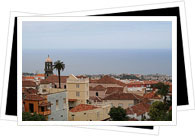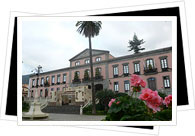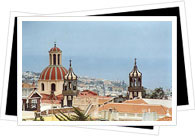Highlights:
 In a Nutshell:
In a Nutshell:
Wooded hillsides, tropical fruit plantations and the incredible Mount Teide provide the stunning background for this town of 40,000. In fact, a hefty chunk of the Mount Teide National Park and the La Corona Forestal Natural Park, known as the lung of Tenerife, is found in the La Orotava region.
In the region's early days, it was the largest and richest of the nine Guanche feifdoms as well as the last Guanche stronghold to fall to the Spanish conquerors. Once under Spanish power, a city began to unfold which quickly attracted Spanish, Italian and Flemish nobility who resided in La Orotava particularly in the 17th and 18th centuries. The small city that you see today boasts the nooks and crannies most typical of Canarian architecture and is one of the best spots in Tenerife for local culture and traditions.
 La Orotava Culture:
La Orotava Culture:
Celebrating both the past and the present, La Orotava is one of the top cultural spots in Tenerife. It's essentially a showcase of traditional Canarian architecture.
Lining picturesque squares and wide streets you will find elegant churches, noble homes and the traditional Canarian houses with balconies and shaded courtyards. La Orotava's quaint historical center - in a perfect state of conservation - has been declared of National Historical and Artistic Interest.
In additional to its incredible architecture, La Orotava is also one of Tenerife's cultural and traditional cores. The city has an well-known artisan tradition, making it one of the top spots to shop for some mementos in the form of ceramics, laces, wood work, leather, etc. In fact, La Orotava has several artisan museums and centers, such as the Museo de Artesanía Torrehermosa, the Museo de Artesanía Iberoamericana and the artisan center inside the Casa de los Balcones.
Further contributing to the cultural scene and shedding light on traditional Canarian culture are folk music groups, Canarian sports and local festivals like the Romería de San Andrés. The shining star of La Orotava's festivals, however, is without a doubt the Corpus Christi. Carpets of flower petals and crafted along the procession route, culminating in an enormous tapestry made entirely of the peculiar volcanic sands that depict various Biblical scenes
La Orotava Beaches:
While the town of La Orotava itself doesn't sit on the ocean, the region of La Orotava does hit the coastline in one point. On the northern coast you'll find a few small, interesting and fairly secluded black sand coves enclosed by beautiful rock walls typical of the rugged northern coastline. Some of these beaches are reachable by car while others are accessible by foot only. Check out El Bollullo, Martín Alonso, El Ancón and Los Patos- don't expect to see much clothing being worn on the Los Patos beach though!
 La Orotava Tourism:
La Orotava Tourism:
From noble houses to stunning plazas, beautiful churches and a mishmash of other sights, La Orotava is veritably jam-packed with must-sees for any visitor. Attesting to the so-called important families of La Orotava's past are several noble houses worth a glance: Casa de Lercaro, Casa de Zárate-Machado, Casa de Mesa, Casa de Monteverde, Casa de Ponte y Franchi... the list is endless.
One of the most popular stops is without a doubt the Casa de los Balcones (House of the Balconies). Built in 1632, it is known for its characteristic wooden balconies both outside and inside as well as for its beautiful interior courtyard brimming with potted plants. Inside, there is a workshop where you can see artisans at work as well as purchase genuine products.
A walk around will show that La Orotava certainly doesn't lack churches. Be sure to check out the Iglesia de la Concepción which, along with being declared a National Monument, is one of the best examples throughout the islands of the Canarian take on Baroque religious architecture. The graceful structure features red and blue stained glass windows through which the sun shines and gives the interior a unique purple glow. Other religious highlights include the 17th century Iglesia de San Juan Bautista, the Iglesia de San Francisco and the coffered Mudéjar ceilings of the 17th century Iglesia de San Augustín.
For nature lovers, there are two stops that you can't pass up. First is the Hijuela del Botánico, a botanical garden brimming with thousands of exotic species from Spain, Africa, Australia, Asia and the Americas and featuring the infamous dragon trees- an emblem from Tenerife's folklore and even considered sacred by the Guanches. The second stop is just outside of the city at the Mirador de Humboldt (Humboldt Viewpoint), which will give you the most incredible view of the immense La Orotava Valley with Mount Teide in the background.
Finally, if you're a wine-lover you'll appreciate the fact that the Valle de la Orotava (Orotava Valley) is one of Tenerife's five wine-producing region with a Mark of Origin. The verdant valley spreading out before you from the Humboldt Viewpoint provides the city with hoards of fresh fruits and vegetables, one of which is the beloved grape. So at the end of a fulfilling day of soaking in La Orotava's culture, kick back and relax with some of the local red wine.